-
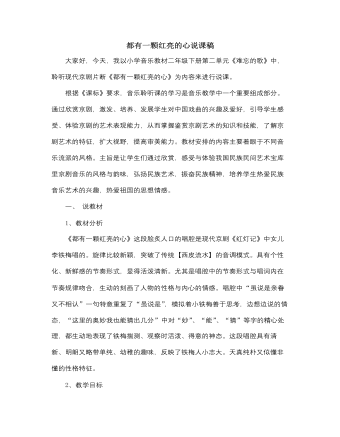
人音版小学音乐二年级下册都有一颗红亮的心说课稿
师介绍念白主要分京白和韵白:京白是经过艺术加工的北京方言,节奏鲜明,重点突出。韵白具有一种典雅而夸张的韵味,是对古代人物语言的艺术变形。(用《红灯记》中李奶奶的一句话:“你姓陈,我姓李,你爹他姓张!”示范用京白,韵白念后,带学生用京白学念两遍。)(五) 再听现代京剧片段《都有一颗红亮的心》1. 引导学生结合音乐欣赏,初步了解感受其唱腔特点。师:京剧主要两大唱腔(二黄原板与西皮流水),今天我们来了解下“西皮流水”唱腔的点:投影西皮流水是一种节奏紧凑;旋律起伏变化比较大;唱腔明朗、活泼、流畅;善于表现喜悦、激动、高昂的情绪唱腔。(六)课堂小结京剧是博大精深的,这节课仅仅给同学们起到了引导作用,希望这节课能成为我们热爱京剧的良好开端,让我们打开京剧大门,一起去真正揭开京剧神秘的面纱,做一个自豪的中国人。
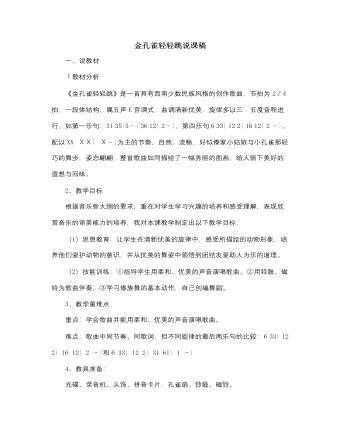
人音版小学音乐二年级下册金孔雀轻轻跳说课稿
4、大胆尝试,用柔和优美的声音演唱歌曲。在熟悉节奏旋律后,解决了难点的基础上,学生对歌曲的学习已是轻松自如了。在此过程中,我采用多种形式让学生练习唱歌:齐唱、分组唱、分男女生唱、个别演唱等多种演唱形式,充分发挥学生的演唱才能。5、成立简易乐队。在唱好了歌的基础上,激发学生用一些简易乐器为歌曲伴奏,利用铃鼓、磁铃为歌曲伴奏。老师用铃鼓示范,磁铃主要用在打击长音处。学生分组练习用铃鼓和磁铃为歌曲伴奏。这样,既培养学生的节奏感,也使他们有一定的成就感。6、创编活动:美的旋律、美的歌词更需要美的舞姿。为了激发学生学舞的兴趣,老师随音乐表演一段,然后重点把傣族的几个基本动作给学生示范一次:孔雀鹤立、孔雀开屏、傣族舞语汇,鼓励学生三五个一组,互相启迪、创作,老师指导、观察,请一些创编的好的同学在前边来表演,音乐再次响起,让每一个学生都动起来,各尽其能、各得其乐、各有所获。整节课都让学生处于愉悦之中。
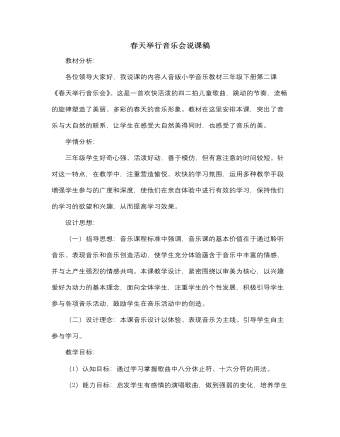
人音版小学音乐三年级下册春天举行音乐会说课稿
三、深入学习体验春之歌声——唱春天在新歌学唱环节,仍然以春天音乐会为主线,通过老师的导入“今天咱们就来学唱这次音乐会的主题歌《春天举行音乐会》,教师进行范唱,进而激发学好主题歌的愿望,再通过用“啦”模唱歌谱、有节奏的朗读歌词增强对歌曲的了解,音乐会节目的形式多样,除了它们四个音乐家独奏之外,还有合奏的地方,再提出滴答答答答︱沙沙0沙|沙沙?|轰隆隆隆隆|哗啦0啦|哗啦?|难点乐句中节奏的变化即十六分音符的用法,在学唱歌曲过程中,采用分角色接龙表演唱等形式,让学生在聆听中主动感受、体验歌曲的意境,并从歌曲的速度、力度等音乐要素出发,引导学生在参与表演中感受歌曲,感悟春雨的轻柔、春雷的有力,春水的热情、春笋的自豪应如何唱,重视学生思维的创造和发展过程,让学生明白怎样才能更好的表现歌曲,而不是单纯的停留在只是会唱歌曲的基础上,在此过程中进一步的培养了学生的音乐审美技能。四、创造表现,再现春之和谐。——颂春天
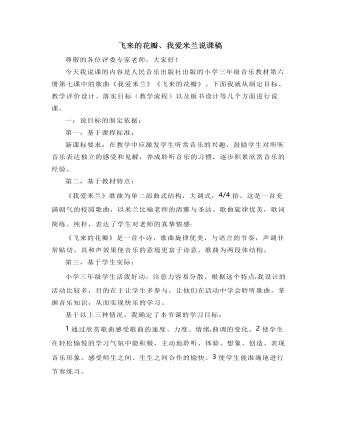
人音版小学音乐三年级下册飞来的花瓣、我爱米兰说课稿
1、运用橡皮筋听音乐学生讨论并回答。《我爱米兰》曲调跳荡《飞来的花瓣》曲调平稳2、运用学生自带的钥匙链等能发出声音的第二次欣赏《我爱米兰》《飞来的花瓣》老师引导学生分析乐曲节奏的不同《我爱米兰》节奏紧密《飞来的花瓣》节奏宽松6、运用身体动作第三次次欣赏《我爱米兰》《飞来的花瓣》老师引导学生分析乐曲速度的不同《我爱米兰》速度稍快《飞来的花瓣》速度中速7、运用彩色纸第四次欣赏《我爱米兰》《飞来的花瓣》老师引导学生分析乐曲情绪的不同《我爱米兰》情绪明快《飞来的花瓣》情绪深情(五)拓展延伸这一环节主要是让学生积累课外的音乐知识,拓宽学生的文化视野,提高学生的人文素养。最后,请大家用自己的话说说对歌曲的理解?师生在《长大后我就成了你》的歌曲声中结束本课。六:板书设计:层次分明。对比清晰谢谢大家!我的说课到此结束,敬请各位评委老师多多给予指导。
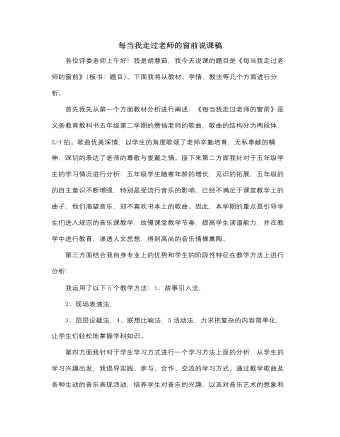
人音版小学音乐三年级下册每当我走过老师的窗前说课稿
在聆听的过程中我让学生认真思考:歌曲的情绪是怎样的?力度怎样?歌曲可分为几部分?(教师相机板书)首先我从第二部分开始教起,首先让学生跟音乐轻声的演唱,可以先试唱歌谱再唱歌词,特别要提醒“啊”的演唱要唱出对老师的深情。歌曲播放完后,教师与学生来进行合作:教师演唱第一部分,学生演唱第二部分。让学生通过与老师的合作加深对第一部分的印象:接下来学习第一部分:我让学生轻声跟音乐演唱,教师指导音高、节奏、音色、歌唱的状态。然后让学生用圆润、饱满的声音完整的来演唱。(教师对学生的演唱进行评析),然后老师让学生再演唱一次并达到以下的演唱要求:第一段用稍弱的音量、稍慢的节奏,第二段用感激的心情、中速来进行演唱。接下来的时间让学生进行分组唱、轮唱、领唱、合唱的方式进行互动一下,培养学生的协作能力。最后,让学生在深情的音乐中结束课堂。最后一方面板书的设计上分析:把歌曲的题目、复杂的节奏、歌曲的情绪、速度简洁的在教学的过程中板书出来。
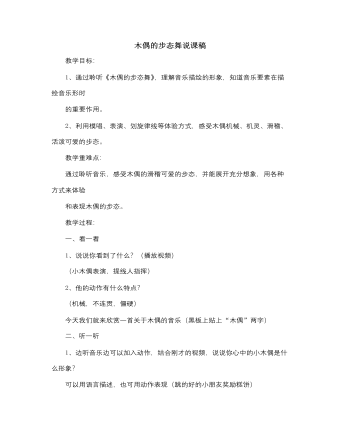
人音版小学音乐三年级下册木偶的步态舞说课稿
5、好,非常不错,请你上来把这个名字写下来吧。6、老师觉得这段音乐还缺点什么,于是我做了一些变化,来听听,这段音乐和之前比起来,都有哪些变化呢?(出示比一比课件)六、比一比1、(速度慢了,音高变低了,力度变弱了,乐器多了弦乐器,音乐多了B主题)2、小木偶心情怎么样了?别着急,我们再来听听(分别聆听①②片段)3、老师把这个主题称之为B主题,谁来给这个主题取一个生动的名字呢?4、小木偶很伤心,谁来说一句话鼓励鼓励他?5、小木偶听到你们的话了,接着来听听,小木偶心情又有什么变化?6、变得高兴起来了,又挑起了刚才的“快乐舞”(贴上A1主题,写上“快乐舞”)7、那现在我们完整的来聆听曲子吧,听到“快乐舞”时用舞蹈表示,听到“悲伤舞时坐下来划旋律线表示。
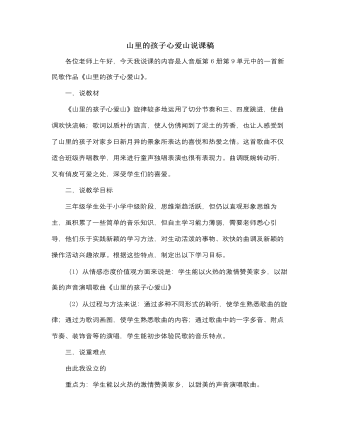
人音版小学音乐三年级下册山里的孩子心爱山说课稿
(1)喊:喂--喂;你好啊--你好啊;(2)唱:有旋律的,2468小节的旋律"喂喂喂""哗啦啦""叮咚叮咚"(3)这些都可能是山里的什么声音?师生讨论(4)师生接唱"大山的回声--喂喂喂;风吹树叶--哗啦啦;山里的泉水--叮咚叮咚;山里的歌声--多动听"连接话题:如果你到了山里,你最想做什么事情?那我们就去山里摘一摘果子吧!第二部分学唱部分1、播放伴奏音乐,师生一起根据音高,做摘果子和吃果子的律动2、再次播放伴奏,边哼唱边表演摘果子动作过渡句:自己摘的果子可真好吃啊,我们以拉歌的形式把山里的小伙伴也叫出来吧!3、第三遍播放伴奏,教师范唱前8小节4、熟悉歌词以画图的方式,将歌词展现出来山里的孩子心爱山,从小就生长在山路间,山里的泉水香喷喷,山里的果子,肥又甜,山里的孩子心爱山,山里有我的好家园,山上是我们村里的树,山下是我们村里的田。
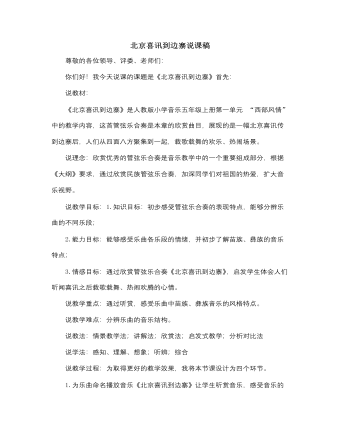
人音版小学音乐五年级下册北京喜讯到边寨说课稿
师生一起听赏,然后,我弹奏乐曲,学生视唱乐段。在视唱过程中划出第三部分结构(由两个乐段和尾声构成)。并一起总结第三部分最明显的特点:再现了旋律A。并且将两段旋律进行对比:第三部分旋律较旋律A的情绪要欢快、激昂。我再启发学生说出这一部分是由哪些乐器演奏的,及分别表现了怎样的场景?由于之前分析的过程中,学生们对部分乐器都比较熟悉了,所以,问题提出之后,他们很快就找到了所有出现的乐器:小号奏出了粗犷、热情的旋律,与后面小提琴奏出的轻快、跳跃的旋律形成了鲜明的对比,表现了一幅小伙子与姑娘对舞的场面。最后,完整地将乐曲听赏一遍,感受不同部分的不同情绪,全班再次分男女生进行即兴表演,在合作学习中将音乐升华。4.拓展延伸完整地欣赏乐曲之后,我将学生分小组进行讨论:用怎样的方式来表现音乐,第二部分最好用舞蹈来表现。
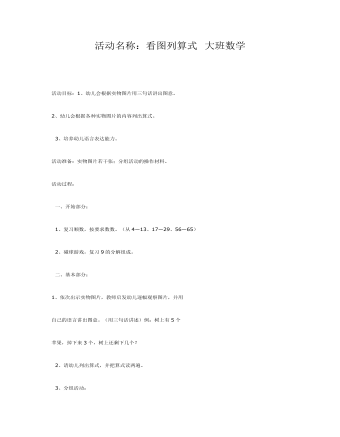
大班数学:看图填算式课件教案
2、幼儿会根据各种实物图片的内容列出算式。 3、培养幼儿语言表达能力。活动准备:实物图片若干张;分组活动的操作材料。活动过程: 一、开始部分: 1、复习顺数,按要求数数。(从4—13、17—29、56—65) 2、碰球游戏,复习9的分解组成。
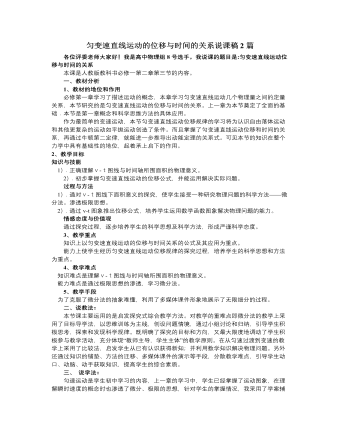
人教版新课标高中物理必修1匀变速直线运动的位移与时间的关系说课稿2篇
培养学生合作交流意识和探究问题的能力,这一部分知识层层递进,符合学生由特殊到一般、由简单到复杂的认知规律。4、互动探究(1)极限思想的渗透让学生阅读“思考与讨论”小版块.培养学生的自学和阅读能力提出下列问题,进行分组讨论:a、用课本上的方法估算位移,其结果比实际位移大还是小?为什么?b、为了提高估算的精确度,时间间隔小些好还是大些好?为什么?针对学生回答的多种可能性加以评价和进一步指导。让学生从讨论的结果中归纳得出:△t越小,对位移的估算就越精确。渗透极限的思想。通过小组内分工合作,讨论交流,培养学生交流合作的精神,以及搜集信息、处理信息的能力;通过小组间对比总结,使学生学会在对比中发现问题,在解决问题过程中提高个人能力;
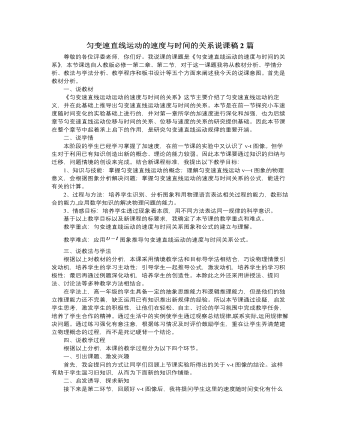
人教版新课标高中物理必修1匀变速直线运动的速度与时间的关系说课稿2篇
设计意图:几道例题及练习题,其中例1小车由静止启动开始行驶,以加速度 做匀加速运动,求2s后的速度大小?进而变式到:小车遇到红灯刹车……,充分体现了“从生活到物理,从物理到社会”的物理教学理念;例题及练习题由浅入深、由易到难、各有侧重,体现新课标提出的让不同的学生在物理上得到不同发展的教学理念。这一环节总的设计意图是反馈教学,内化知识。(6) 小结归纳,拓展深化我的理解是,小结归纳不应该仅仅是知识的简单罗列,而应该是优化认知结构,完善知识体系的一种有效手段,为充分发挥学生的主题作用,从学习的知识、方法、体验是那个方面进行归纳,我设计了这么三个问题:① 通过本节课的学习,你学会了哪些知识;② 通过本节课的学习,你最大的体验是什么;③ 通过本节课的学习,你掌握了哪些学习物理的方法?
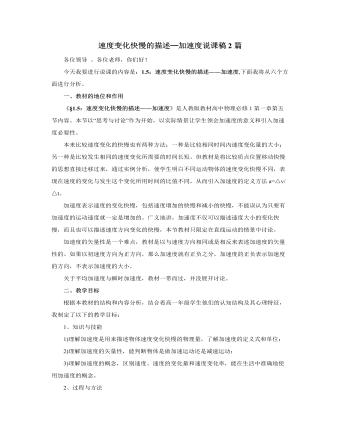
人教版新课标高中物理必修1速度变化快慢的描述─加速度说课稿2篇
本来比较速度变化的快慢也有两种方法:一种是比较相同时间内速度变化量的大小;另一种是比较发生相同的速度变化所需要的时间长短。但教材是将比较质点位置移动快慢的思想直接迁移过来,通过实例分析,使学生明白不同运动物体的速度变化快慢不同,表现在速度的变化与发生这个变化所用时间的比值不同,从而引入加速度的定义方法a=△v/△t。加速度表示速度的变化快慢,包括速度增加的快慢和减小的快慢,不能误认为只要有加速度的运动速度就一定是增加的。广义地讲,加速度不仅可以描述速度大小的变化快慢,而且也可以描述速度方向变化的快慢,本节教材只限定在直线运动的情景中讨论。加速度的矢量性是一个难点,教材是以与速度方向相同或是相反来表述加速度的矢量性的。如果以初速度方向为正方向,那么加速度就有正负之分,加速度的正负表示加速度的方向,不表示加速度的大小。
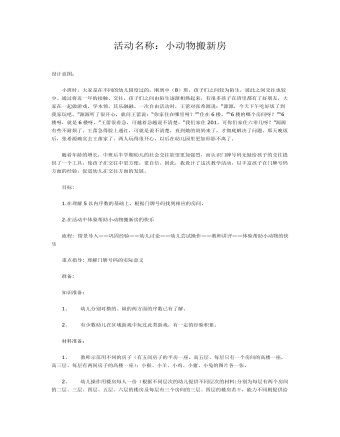
中班数学:小动物搬新房课件教案
目标:1.在理解5以内序数的基础上,根据门牌号码找到相应的房间。2.在活动中体验帮助小动物搬新房的快乐 流程: 情景导入——巩固经验——幼儿讨论——幼儿尝试操作——教师讲评——体验帮助小动物的快乐 重点指导: 理解门牌号码的实际意义 准备: 知识准备:1、 幼儿分别对横的、纵的两方面的序数已有了解。2、 有少数幼儿在区域游戏中玩过此类游戏,有一定的经验积累。 材料准备:1、 教师示范用不同的房子(有五间房子的平房一座,高五层、每层只有一个房间的高楼一座,高三层、每层有两间房子的高楼一座);小猴、小羊、小鸡、小猪、小兔的图片各一张。2、 幼儿操作用楼房每人一份(根据不同层次的幼儿提供不同层次的材料:分别为每层有两个房间的二层、三层、四层、五层、六层的楼房及每层有三个房间的三层、四层的楼房若干,能力不同则提供给不同的材料。这样,在横的、总的两方面都拉开了距离,满足了不同 幼儿的发展,使不同幼儿在体验成功快乐的基础上经验都得到一定的提升);身上写有门牌号码的小动物若干。3、 皱纸做的用于庆祝的彩带;录有《喜洋洋》音乐的磁带。
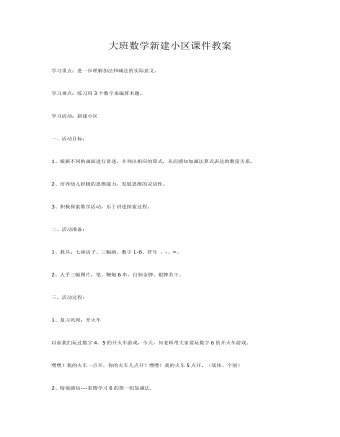
大班数学新建小区课件教案
学习活动:新建小区一、活动目标: 1、根据不同的画面进行讲述,并列出相应的算式,从而感知加减法算式表达的数量关系。 2、培养幼儿积极的思维能力,发展思维的灵活性。3、积极探索数学活动,乐于讲述探索过程。二、活动准备:1、教具:七座房子、三幅画、数字1-6、符号 、-、=。2、人手三幅图片,笔、鞭炮6串、自制金牌、银牌若干。
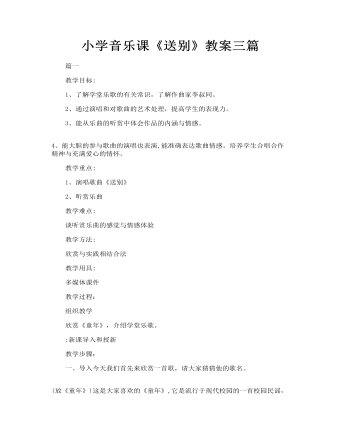
小学音乐课《送别》教案三篇
一、导入今天我们首先来欣赏一首歌,请大家猜猜他的歌名。 (放《童年》)这是大家喜欢的《童年》,它是流行于现代校园的一首校园民谣,那么我们思考一下,如果我们追溯到“五四”时期,那时学堂里又在唱些什么?那时人们把在学堂里唱的歌叫乐歌,因此就把20世纪初流行于学校的歌曲,叫学堂乐歌。学堂乐歌除向学生进行思想和知识教育外,还有反映人们要求“富国强兵”、“抵御外辱”的,还有宣传学习科学,反对封建迷信的。今天我们就来学习一首学堂乐歌《送别》
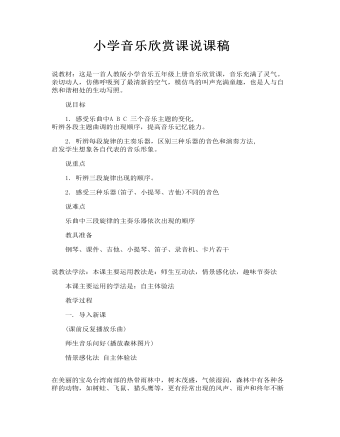
小学音乐欣赏课说课稿
1. 感受乐曲中A B C 三个音乐主题的变化, 听辨各段主题曲调的出现顺序,提高音乐记忆能力。 2. 听辨每段旋律的主奏乐器,区别三种乐器的音色和演奏方法, 启发学生想象各自代表的音乐形象。 说重点 1. 听辨三段旋律出现的顺序。 2. 感受三种乐器(笛子、小提琴、吉他)不同的音色 说难点 乐曲中三段旋律的主奏乐器依次出现的顺序 教具准备 钢琴、课件、吉他、小提琴、笛子、录音机、卡片若干 说教法学法:本课主要运用教法是:师生互动法,情景感化法,趣味节奏法 本课主要运用的学法是:自主体验法
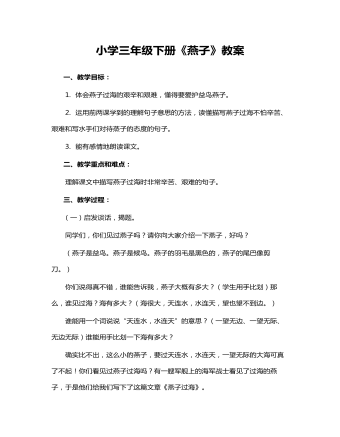
小学三年级下册《燕子》教案
一、教学目标:1. 体会燕子过海的艰辛和艰难,懂得要爱护益鸟燕子。2. 运用前两课学到的理解句子意思的方法,读懂描写燕子过海不怕辛苦、艰难和写水手们对待蒸子的态度的句子。3. 能有感情地朗读课文。二、教学重点和难点:理解课文中描写燕子过海时非常辛苦、艰难的句子。三、教学过程:(一)启发谈话,揭题。同学们,你们见过燕子吗?请你向大家介绍一下燕子,好吗?(燕子是益鸟。燕子是候鸟。燕子的羽毛是黑色的,燕子的尾巴像剪刀。)你们说得真不错,谁能告诉我,燕子大概有多大?(学生用手比划)那么,谁见过海?海有多大?(海很大,天连水,水连天,望也望不到边。)谁能用一个词说说“天连水,水连天”的意思?(一望无边、一望无际、无边无际)谁能用手比划一下海有多大?确实比不出,这么小的燕子,要过天连水,水连天,一望无际的大海可真了不起!你们看见过燕子过海吗?有一艘军舰上的海军战士看见了过海的燕子,于是他们给我们写下了这篇文章《燕子过海》。教师范读(二)学生质疑。读了这篇课文你有什么问题呢?(燕子为什么要过海?为什么它要不分昼夜地飞?为什么像雨点一样落下来?)
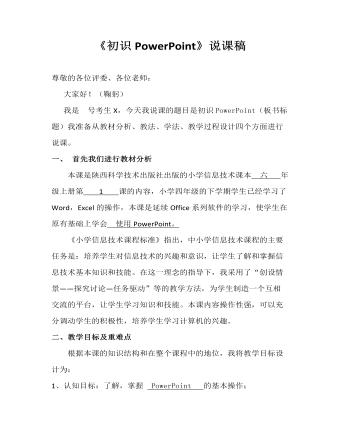
小学信息技术说课稿(初识PowerPoint)
一、 首先我们进行教材分析本课是陕西科学技术出版社出版的小学信息技术课本 六 年级上册第 1 课的内容,小学四年级的下学期学生已经学习了Word,Excel的操作,本课是延续Office系列软件的学习,使学生在原有基础上学会 使用PowerPoint。
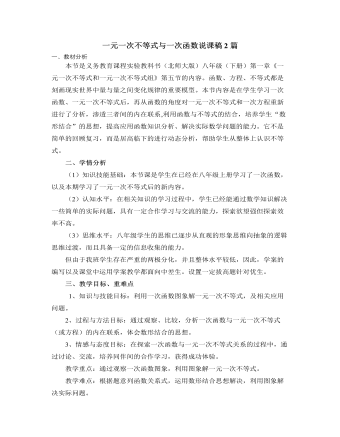
北师大版初中数学八年级下册一元一次不等式与一次函数说课稿2篇
由于任何一个一元一次不等式都能写成ax+b>0(或<0)的形式,而此式的左边与一次函数y=ax+b的右边一致,所以从变化与对应的观点考虑问题,解一元一次不等式也可以归结为两种认识:⑴从函数值的角度看,就是寻求使一次函数y=ax+b的值大于(或小于0)的自变量x的取值范围。⑵从函数图像的角度看,就是确定直线y=ax+b在x轴上(或下)方部分所有的点的横坐标所构成的集合。教学过程中,主要从以上两个角度探讨一元一次不等式与一次函数的关系。1、“动”―――学生动口说,动脑想,动手做,亲身经历知识发生发展的过程。2、“探”―――引导学生动手画图,合作讨论。通过探究学习激发强烈的探索欲望。3、“乐”―――本节课的设计力求做到与学生的生活实际联系紧一点,直观多一点,动手多一点,使学生兴趣高一点,自信心强一点,使学生乐于学习,乐于思考。4、“渗”―――在整个教学过程中,渗透用联系的观点看待数学问题的辨证思想。

人教版新课标高中地理必修2第一章第三节人口合理容量教案
生:环境承载力是指环境能持续供养的人口数量。师:对了。但是有同学仍然会感到这是一个很抽象的概念。下面我们具体来了解什么是环境承载力。我们可以从两个部分去理解:一、环境,它主要是指环境的单个要素(如:土地、水、气候、植被等。)及其组合方式。二、是承载力,它指在特定的条件下,具体某事物能承受的某种活动的最大值。那环境承载力的科学定义是怎样表达的呢?生:环境承载力是指某一时期,某种状态条件下,某地区环境所能承受的人类活动作用的阈值。师:很对。 我们可以用一个生动的例子来说明。一只木桶里面的水的多少在底面积固定不变的情况下是由哪块木板来决定?生:最短的那块。师:确实如此。这就是我们平常所讲的 “木桶效应”。那影响环境承载力的大小也是由环境个要素里面最紧缺的那个要素来决定的。下面我们用一个例子来印证一下。

